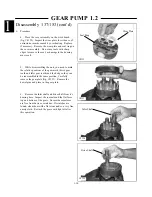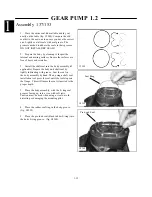
1
GENERAL INFORMATION 1.1
Refer to figure C2018 on page 1-2.
Oil is drawn from the hydraulic oil reservoir through a
100 micron element. From there it travels to the main
hydraulic pump.
•The hydraulic pump is a gear type which is driven by a
shaft and coupler through the hydrostatic drive pump at
engine speed. The oil then flows from the gear pump to
the hydraulic control valve.
•The hydraulic control valve is equipped with an
adjustable relief valve which is adjusted to 2400 psi
(165.5 bar). The control valve is a series type with 3
spools (banks). The various spools activate the boom,
bucket and auxiliary hydraulic functions.
When the spools are in neutral, oil flows from the
hydraulic gear pump, through the control valve and
returns to the hydraulic cooler, to the 5 micron hydraulic
filter. From the hydraulic filter, the fluid flows to charge
the tandem hydrostatic pump and pressurize the hydraulic
brake release system and then back to the hydraulic
reservoir. As a spool is moved, oil is directed to one of
the valve ports and oil flows out to operate a function.
The return oil coming back from this operation is ported
to the next valve section which allows operation of more
than 1 function at the same time. This is a series type
valve function.
Each spool end contains a centering spring which returns
the spool to neutral when the foot pedal, or control
handle, is released.
•The boom section, on foot control operated loaders, has
a detent mechanism to hold the spool in the float position.
The auxiliary section is operated by foot pedal operation,
or may have an optional electrical solenoid operated
control, and may be engaged momentarily by the control
lever mounted switch, forward or reverse, or by engaging
the dash mounted toggle switch for constant power in the
forward direction only.
The system relief valve operates when ever a hydraulic
function has been restricted or overloaded (fig. C3746).
To protect against excessive pressure build up, the relief
valve opens and allows oil to return to the valve outlet.
The system relief valve is adjustable, and is preset at
2400 psi (165.5 bar).
•Load check valves are located between the ports of each
spool circuit. The function of the load check valve is to
hold the boom arms or bucket in position during initial
spool movement (fig. C3717).
C3746
C3717
1-5
Relief Valve
Load Check Valve
Control valve location
Gear pump location
C4226
C4223































